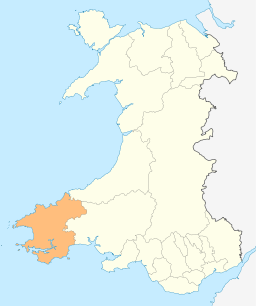Angle, Pembrokeshire
| Angle | |
|---|---|
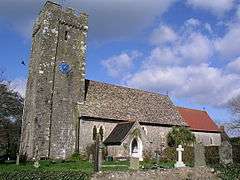 Saint Mary's Church, Angle | |
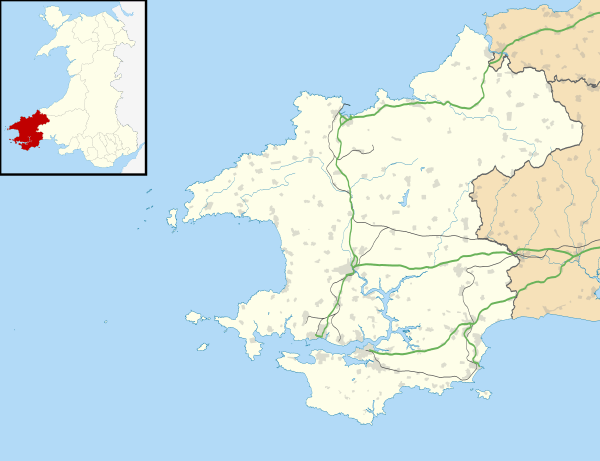 Angle Angle shown within Pembrokeshire | |
| Population | 337 (2011)[1] |
| OS grid reference | SM8602 |
| Community |
|
| Principal area | |
| Country | Wales |
| Sovereign state | United Kingdom |
| Post town | Pembroke |
| Postcode district | SA71 |
| Dialling code | 01646 |
| Police | Dyfed-Powys |
| Fire | Mid and West Wales |
| Ambulance | Welsh |
| EU Parliament | Wales |
| UK Parliament | |
| Welsh Assembly | |
Angle (Welsh: Angl) is a village and community situated on the southern side of the entrance to the Milford Haven Waterway in Pembrokeshire, Wales. It has a school, two pubs, a village shop with a post office and St Mary's church[2]. There is a bus link to Pembroke railway station.
The Sailors' Chapel, a Grade I listed building, is in the church graveyard.[3]
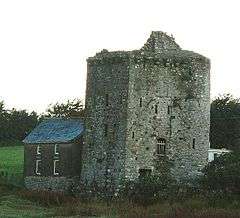
At Castle Farm, there is a Pele tower and above Castle Bay there are the remains of an Iron Age fort. On the headland there are visible remains of medieval strip farming.
Angle bay is a wilderness of mud and sand making it a good home for invertebrates making it popular with many bird species such as dunlin, grey plover, common redshank, Eurasian oystercatcher and Eurasian curlew. The nearby Kilpaison Marsh has been a breeding area for Cetti's warbler in the reed beds and scrub.[4] West Angle Bay is a Site of Special Scientific Interest, with rock pools which are home to the rare cushion starfish, and also a sandy beach .[4]
The Angle Lifeboat Station received silver medals in 1878[5] for rescuing the crew of the Loch Shiel from rocks near Thorn Island. The ship had been carrying a cargo of whisky and beer.[6]
St. Mary's church
The church which stands in the centre of the village, is thought to have been built in the thirteenth century with the tower added in the fifteenth century. The church's grounds include a number of graves of victims of the Japanese ship Hirano Maru that was torpedoed locally during World War I; the memorial was re-dedicated in 2018.[7] The church contains memorials to the Mirehouse family of The Hall, Angle, as well as ancient monuments to the families of Ferrers and Dawes of Bangeston.[3]
Sailors' Chapel
The Sailors' Chapel, a Grade I listed building dedicated to St. Anthony, is in the church graveyard. Beneath the chapel is a crypt where until the early twentieth century, many anonymous seamen's bodies that had been found on the coastline were readied for burial.[3]
The chapel is a small, single-cell vaulted building above a raised and vaulted crypt. It was founded in the 15th century (1447) by Edward de Shirburn a "knight of Nangle". It was restored in 1853, again by Elizabeth Mirehouse in 1862, and rededicated in 1929. Originally a receiving place, or charnel-house, for the corpses of drowned sailors, it became a chapel of rest in the 20th century.[8]
Constructed of coarse masonry under a modern tiled roof with a Celtic cross finial, the chapel has Victorian stained glass windows, one of which depicts the miracle of Christ walking upon the sea. There is a stone altar.[8]
History
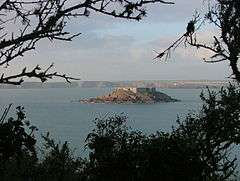

A Pele tower was built by Robert de Shirburn in the 14th century.[9] It is within Castle Farm but can be easily accessed. The castle may have been built by the Shirburn family during the time of Owain Glyndŵr. A French army landed at Angle in 1405 to assist Glyndŵr. Some sources see the castle as a simple pele tower but others see evidence of a moat and another tower and regard what survives as being the remains of a larger castle.[10]
In the 19th century, it was reported that 388 people lived in the village with the women involved in plaiting straw for bonnets and mats, whilst the men would trawl for oysters when they were in season.[2]
In the same century, many forts were constructed around the Milford Haven Waterway—Angle has three—Thorn Island, East Blockhouse Battery and Chapel Bay. Their construction was at the behest of Lord Palmerston following a Royal Commission.[11]
The chief landowners in Angle were the Mirehouse family for many generations;[12] descendants of John Mirehouse of Brownslade, Pembrokeshire, who purchased the Angle estate from the Kinner family for £29,000 shortly after 1800.[13] The family later made The Hall its main seat after extensive refurbishment in the 1830s.[14] John Mirehouse was appointed High Sheriff of Pembrokeshire in 1831, and Lt. Col. Richard Walter Byrd Mirehouse served as High Sheriff in 1886.[15][16]
By 1886, John Mirehouse's descendant, Lt. Col. Richard Walter Byrd Levett of Staffordshire, graduate of Eton and Christ Church, Oxford, had taken the surname of his mother's family and had settled in the village.[17] Lt. Col. Mirehouse lived at The Hall, where his descendants continue to live today, and where he embarked on making improvements to the estate and the village. This included constructing a number of buildings; one being the castellated, eclectic, colonial-style Globe Hotel; once the main village hotel and still a prominent feature in this Victorian estate village.
The Mirehouse estate included Cheveralton Farm and Hubberton Farm. The family also owned the Golden Estate in Pembroke and Wallaston Farm in Pembroke St. Mary.[18][19] Councillor John Allen-Mirehouse of Angle currently serves as Pembrokeshire County Council Deputy Leader.[20]
During World War II, RAF Angle was located on the Angle Peninsula Coast. It was operational from 1 December 1941 to the 1950s, having been used by both the Royal Air Force and the Royal Navy.
The sheltered beach at West Angle Bay has been designated a Site of Special Scientific Interest; the rock pools are home to a small green starfish called Asterina phylactica.[21] The starfish was only formally identified in 1979.[22]
On 15 February 1996, the oil tanker Sea Empress grounded at the entrance to the Milford Haven Waterway, spilling 72,000 tonnes of crude oil. The coastline around Angle was severely damaged. The effect of the oil spill lasted several years and cost £60 million.[23]
Lifeboat Station

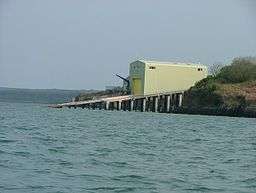
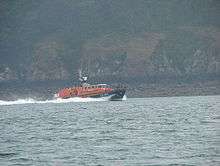
A lifeboat station was established here in 1868; since then there have been a number of lifeboats and even a number of different slipways. The crew here has received numerous awards including seven silver medals from the RNLI.[5] In 2008 there are two lifeboats, The Lady Rank and the smaller Richard John Talbot Miller.
The first rescue where the crew received silver medals was in the rescue of 27[5] (some say 33[24]) people who were on board the 1878-built Loch Shiel which had run into rocks off Thorn Island. Two lifeboat crew members and the honorary secretary received silver medals. One of these crew members was Thomas Rees. He is buried in the church yard at St Mary's. It was said that the lifeboat was unable to reach them but these brave people managed to get to them by climbing around Thorn island and getting a rope to the ship. They literally held on by their finger tips to achieve this.
The rescue is particularly noteworthy as it is described as Wales' "Whisky Galore". The Loch Shiel was carrying goods from Scotland to Adelaide and included gunpowder, beer[25] and 7,500[6] (some say 7,000[24]) cases of Glasgow whisky. Much of this was never recovered. Some of the bottles are still amongst the wreck which are described as "undrinkable", but much of the cargo was only partially recovered by the customs men.[24] It was said that one local drank himself to death on the 100 proof whiskey.[25] In 1999, bottles of beer from the wreck were auctioned for £1000 per bottle.[6]
A bronze medal was awarded to Coxswain James Watkins for rescuing 28 people on the 26 November 1929 from the single-screw steamship Molesley which had been caught by a sudden wind change and a poor decision by its captain.[26] James Watkins went on to be awarded both a silver medal for rescuing 6 people in 1944 from the motor boat Thor and a year later another bronze medal for a difficult rescue of nine people from the steamer Walter L M Russ.[5] (This steamer had been seized from the Germans and sank on the 15 July before it could be renamed the Empire Concourse.[27])
More recently, Coxswain William John Rees Holmes has been awarded two bronze medals. The first was in 1977 when the tanker Donna Marike was thought to be about to explode and the lifeboat stood by her in December 1976. The second bronze medal was for rescuing three people from the fishing boat Cairnsmore on 1 December 1978.[5]
In 1997 a third coxswain, Jeremy R. Rees, and his crew were awarded another bronze medal for rescuing four people after their motor boat, Dale Princess, was blown onto cliffs on Skomer Island. The rescue was made in gale-force winds and stormy seas.[5]
In April 2009, a new £2.2m Tamar class lifeboat replaced the previous Tyne class boat. Funding raising started in 2006 in Pembrokshire and Birmingham, while a single £1.6M donation from Grand Lodge of Mark Master Masons, a branch of the Free Masons in London, enabled final purchase of the boat.[28][29]
References
- ↑ "Community population 2011". Retrieved 18 April 2015.
- 1 2 A Topographical Dictionary of Wales, S. Lewis,, 1844, Genuki, accessed 30 August 2008
- 1 2 3 The Benefice, Rev. Jones, accessed 30 August 2008
- 1 2 "Pembrokeshire Ringing Group". Retrieved 27 January 2016.
- 1 2 3 4 5 6 Angle History Archived October 9, 2008, at the Wayback Machine., RNLI.org, accessed 30 August 2008<
- 1 2 3 Diver sinks £1,000 pint, BBC, accessed 30 August 2008
- ↑ "WW1: New memorial for Pembrokeshire's Japanese dead". BBC News. 4 October 2018. Retrieved 5 October 2018.
- 1 2 "British Listed Buildings: Sailors' Chapel, Angle". Retrieved 6 April 2016.
- ↑ Angle Castle Archived September 22, 2008, at the Wayback Machine., Castles of Britain, accessed 30 August 2008
- ↑ Welsh Castles: A Guide by Counties, Adrian Pettifer, 2000, ISBN 0-85115-778-5
- ↑ https://www.bbc.co.uk/news/uk-wales-south-west-wales-41327413
- ↑ The son of John Mirehouse who purchased the Angle estate married the daughter of the Rev. Dr. John Fisher (Anglican bishop), patron of painter John Constable.
- ↑ John Mirehouse, an agent for John Campbell, 1st Baron Cawdor, first lived in a home built for him at Brownslade by William Thomas, a protege of Lord Cawdor.
- ↑ Angle Estate Papers, Allen-Mirehouse Family of Angle, Pembrokeshire Record Office
- ↑ ‘MIREHOUSE, Lieut-Col Richard Walter Byrd’, Who Was Who, A & C Black, 1920–2007; online edn, Oxford University Press, Dec 2007 accessed 30 Aug 2008
- ↑ Richard Mirehouse, formerly Levett, The Eton Register, Part III, Old Etonian Association, Spottiswoode & Co., Eton, 1906
- ↑ Ranieval, The Marquis of Ruvigny and (1 May 2013) [1903-1911]. The Plantagenet Roll of the Blood Royal: The Mortimer-Percy Volume. Heritage Books. p. 454. ISBN 978-0-7884-1872-3.
- ↑ Angle, Pembrokeshire, Genuki.org
- ↑ Visitation of England and Wales, Vol. 3, Joseph Jackson Howard, Frederick Arthur Crisp, The College of Arms, Privately Printed, London, 1895
- ↑ Pembrokeshire County Council, Pembrokeshire, Wales
- ↑ Angle, VisitPembrokeshire.com, accessed 30 August 2008
- ↑ Asterina phylactica, habitas.org.uk, accessed 31 August 2008
- ↑ BBC Wales On Air:Sea Empress
- 1 2 3 letters, wrecksite.eu, accessed 30 August 2008
- 1 2 Loch Liel, Pembrokeshire wrecks
- ↑ Wreck report for Molesley, 19 August 1930, GB Board of Trade
- ↑ EMPIRE - C, mariners-l.co.uk
- ↑ "Archived copy". Archived from the original on 2008-12-07. Retrieved 2009-04-20.
- ↑ http://www.westerntelegraph.co.uk/news/4211993.Angle_welcomes_new_Tamar_lifeboat/
External links
| Wikimedia Commons has media related to Angle, Pembrokeshire. |
